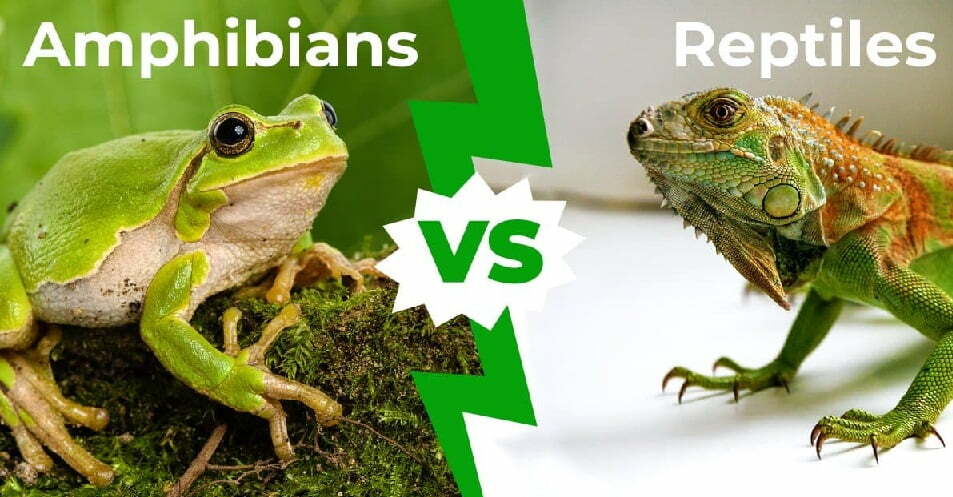Difference Between Reptiles and Amphibians

Difference Between Reptiles and Amphibians, Reptiles and amphibians are both cold-blooded vertebrates, but they have several key differences. Reptiles are characterized by their scaly skin, while amphibians have moist, porous skin. Reptiles also have lungs for breathing, while amphibians can breathe through their skin as well as their lungs. Additionally, reptiles lay their eggs on land, while amphibians lay their eggs in water. Finally, amphibians go through a metamorphosis during their development, while reptiles do not.
Reptiles and amphibians are both groups of cold-blooded, four-legged vertebrates, but they have several key differences that distinguish them from one another.
One of the main differences between reptiles and amphibians is their skin. Reptiles have scaly skin that is covered in scales, plates, or bony plates, while amphibians have moist, porous skin that is often covered in mucus. The scales on reptiles act as a barrier to help them retain moisture and protect them from predators.
Another difference between reptiles and amphibians is their method of breathing. Reptiles have lungs, and they breathe air like mammals and birds do, while amphibians have lungs and also have the ability to breathe through their skin. This is because amphibians have specialized skin that allows them to exchange gases directly with the environment.
Reptiles and amphibians also differ in their reproduction. Reptiles typically lay their eggs on land, while amphibians lay their eggs in water. The eggs of reptiles are often covered in a leathery or hard shell, that protects the eggs from drying out, while the eggs of amphibians are surrounded by a jelly-like substance that helps keep them moist.
Finally, another difference is the development, Amphibians typically go through a metamorphosis during their development, which means that they undergo a significant physical change from the larval stage to the adult stage, while reptiles do not undergo metamorphosis.
Overall, while reptiles and amphibians share some similarities, they are distinct groups of animals that have evolved to adapt to different environments and lifestyles.
Study of Reptiles and Amphibians word craze
Herpetology is the branch of zoology concerned with the study of reptiles and amphibians, also known as herpetofauna. Herpetologists study the biology, ecology, behavior, and evolution of these animals, as well as their conservation and management. This can include research on topics such as the effects of climate change on reptiles and amphibians, the spread of diseases among these animals, and the impact of human activity on their populations.
Herpetologists use a variety of methods to study reptiles and amphibians, including field observations, experiments, and the analysis of museum specimens. They may also use techniques such as genetics and phylogenetics to understand the evolutionary relationships among different species of reptiles and amphibians.
Herpetology is considered as one of the most interesting field of study and there are many passionate researchers who dedicate their lives to understand the diversity, behavior and ecology of these animals. And also, herpetology is also important for conservation, as many species of reptiles and amphibians are facing threats such as habitat loss, over-exploitation, and the introduction of invasive species.
There are several other aspects of herpetology that are worth mentioning.
One is the study of the behavior and ecology of reptiles and amphibians. Herpetologists study how these animals interact with their environment and other species, including their mating and reproductive behaviors, their interactions with predators and prey, and their role in the ecosystem.
Another area of study is the physiology of reptiles and amphibians. Herpetologists study the diseases and parasites that affect these animals, and how they can affect their health and survival.
Herpetology also includes the study of the evolution of reptiles and amphibians. Herpetologists use techniques such as phylogenetics to understand the relationships between different species and to reconstruct the evolutionary history of these groups.
Additionally, herpetology also includes the study of conservation biology of reptiles and amphibians. Herpetologists study the factors that threaten the survival of these animals and develop strategies to protect them.
Overall, herpetology is a broad and interdisciplinary field that encompasses many different aspects of the biology, behavior, ecology, and evolution of reptiles and amphibians, as well as their conservation and management.
Read More: A Field Guide to Western Reptiles and Amphibians
